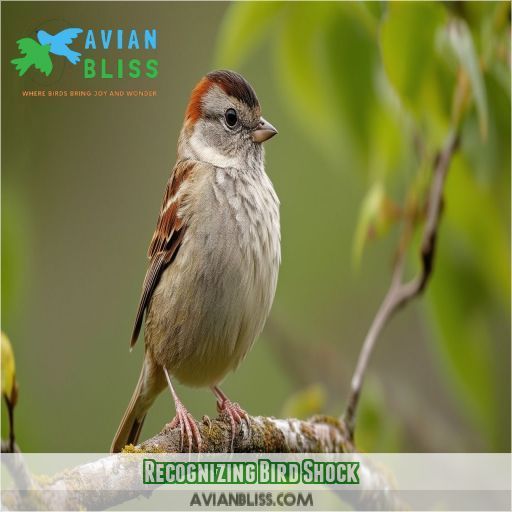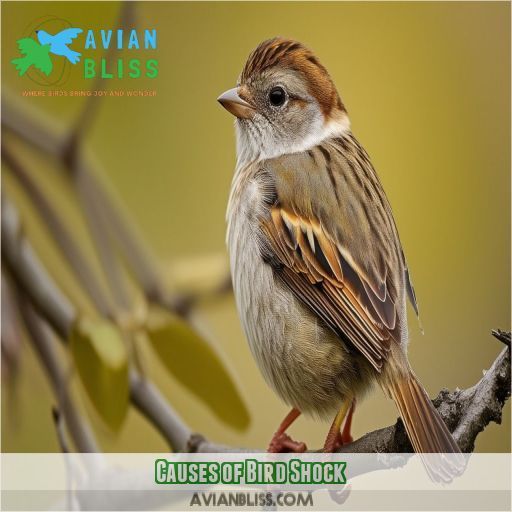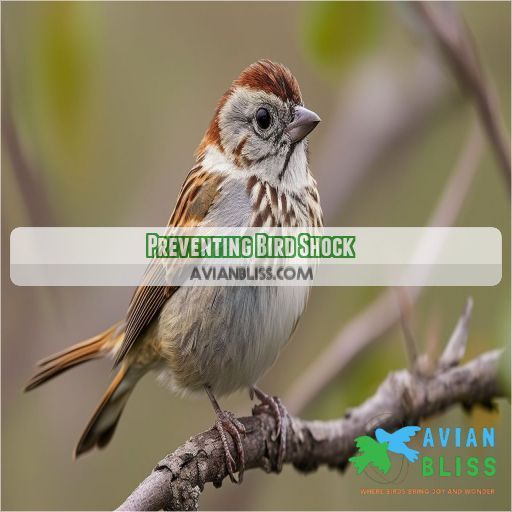This site is supported by our readers. We may earn a commission, at no cost to you, if you purchase through links.

You’ll want to create a quiet, stable, and warm environment for them. Keep reading to learn more about helping a bird in shock.
Table Of Contents
- Key Takeaways
- Recognizing Bird Shock
- Causes of Bird Shock
- First Aid for a Bird in Shock
- Preventing Bird Shock
- Treating Bird Shock
- Frequently Asked Questions (FAQs)
- What to do for a bird in shock?
- How do you tell if a bird is alive or stunned?
- How to tell if a bird is in distress?
- How do I know if my bird is traumatized?
- How do I know if a bird is in shock or just tired?
- What should I do if I see a bird in shock?
- Are there different types of shock in birds?
- How common is bird shock?
- What are the chances of a bird recovering from shock?
- Conclusion
Key Takeaways
- Birds can show signs of shock through weakness, drowsiness, and unusual breathing patterns. Keep an eye out for pale or bluish skin, rapid breathing, and fluffed-up feathers.
- Create a quiet, stable, and warm environment if you suspect a bird is in shock. Minimize distractions and potential stressors to help them calm down.
- Check their breathing rate and examine them for wounds. Treat minor injuries yourself, but don’t hesitate to get them to a vet for more serious issues.
- Keep the bird warm with a heating pad or a warm, damp cloth. Place them in a safe, quiet spot, and offer food and water once they’ve stabilized.
Recognizing Bird Shock
Birds can go into shock just like humans. It’s a serious condition that can be fatal if not treated quickly. You need to know the signs of bird shock so you can give your feathered friend the care it needs.
Weakness and Drowsiness
If your feathered friend is in shock, they might seem super tired and weak.
They could be all sluggish and sleepy, even struggling to stay awake.
Maybe they’re having a hard time moving around or keeping their balance.
That’s their body’s way of saying something’s not right.
Pale or Bluish Skin
Pale or bluish skin in birds is a telltale sign of shock, indicating poor circulation and oxygen levels. Here’s what to look for:
- Skin discoloration: Notice if the bird’s skin, especially around the feet and beak, appears pale or bluish.
- Weakness: The bird may seem weak and unable to perch or balance properly.
- Drowsiness: Birds in shock can become lethargic and sleepy, struggling to stay awake.
If you spot these signs, it’s really important to take immediate action and provide care for the bird.
Panting or Rapid Breathing
If your feathered friend is panting or breathing rapidly, it could be a sign of bird shock. This is often a symptom of distress, indicating that your bird is struggling to get enough oxygen. Here’s a quick overview in a table format:
| Sign | Description |
|---|---|
| Panting | Your bird may be gasping for air, trying to breathe faster to compensate for oxygen deprivation. |
| Rapid Breathing | Notice if your bird is breathing faster than usual. Count the breaths per minute and compare it to their normal breathing rate. |
| Difficulty Breathing | Observe if your bird is struggling to breathe, showing signs of distress, or making unusual breathing sounds. |
Rapid Heartbeat
A rapid heartbeat is another sign of bird shock.
This one can be tricky to spot without a stethoscope, but if you notice any of the other symptoms and suspect shock, act quickly.
Get the bird to a quiet, stress-free zone, and if you have a stethoscope, check its heart rate.
If it’s racing, the bird is likely in shock, and you should seek veterinary care ASAP.
Closed or Swollen Eyes
Keep an eye out for closed or swollen peepers. This could be a sign of head trauma or severe stress. Eye trauma, infection, or vision loss might be the culprit. If you spot any of these, it’s a red flag that your feathered friend needs a vet, stat.
Causes of Bird Shock
Understanding what causes bird shock is really important. From injuries and environmental factors to starvation, poisoning, and stress, let’s explore what can trigger this life-threatening condition and how to spot the signs.
Injuries
Now that you know the signs of bird shock, let’s talk about some common causes, starting with injuries.
Injuries can range from burns to blood loss and head trauma. For example, a cat attack or a collision with a window can cause wounds and trauma severe enough to send a bird into shock.
Keep an eye out for any physical wounds or signs of distress, especially after a known or suspected injury.
Environmental Factors
Environmental factors play a huge role in bird shock.
These factors include heat stroke, hypothermia, and dehydration.
If a bird is exposed to extreme heat, it can lead to heat stroke, causing the bird’s body temperature to rise dangerously.
Similarly, hypothermia can occur when a bird is exposed to cold environments, leading to a drop in body temperature.
Dehydration is another concern, especially in hot weather conditions.
Starvation
Starvation is another common cause of bird shock, and it can happen for a variety of reasons, including:
- Lack of food access: This could be due to a decrease in available food sources or competition from other birds.
- Dietary imbalances: Making sure your bird has a balanced diet with all the necessary nutrients is super important.
- Parent abandonment: Nestlings and hatchlings are particularly vulnerable, as they rely solely on their parents for food.
- Fledgling challenges: Even after leaving the nest, fledglings may struggle to find food on their own, leading to starvation if not monitored.
Poisoning
Poisoning is another common cause of bird shock.
Birds can be accidentally poisoned by a range of substances, including pesticides, herbicides, and other toxic chemicals.
If you suspect your bird has ingested something poisonous, it’s important to act quickly.
Look for symptoms like weakness, difficulty breathing, and pale skin.
If you notice these signs, contact a veterinarian immediately for advice on treatment and to determine the best course of action.
Stress
Stress is a sneaky culprit that can tip your feathered friend into shock. It’s like that annoying neighbor who sets off fireworks at random hours, keeping everyone on edge. Birds, especially sensitive souls like parrots and cockatiel, can fall prey to anxiety and stress, which takes a toll on their health.
But what exactly stresses out our fine-feathered friends? Common triggers include loud noises, sudden changes in environment, and even boredom. Yep, our beaked buddies can get the bird blues too.
First Aid for a Bird in Shock
If you spot the signs of shock in a bird, it’s important to act fast and provide first aid. You can help stabilize the bird and prevent its condition from worsening.
Secure the Bird
If you suspect a bird is in shock, the first step is to secure the bird and reduce its stress levels.
Create a quiet and stable environment, perhaps in a separate room or area away from noise and distractions.
You want to minimize any potential stressors for the bird, so a calm and peaceful setting is ideal.
Think of it as creating a little spa retreat for your feathered friend to help them chill out and recover.
Check for Breathing
Once you’ve secured the bird in a quiet, stable spot, it’s time to check its breathing.
When a baby bird is injured, it’s crucial to know the signs of distress, which is why having an emergency kit and knowing how to use items like saline solution for wound cleaning. This is a key step in first aid for a bird in shock.
Take a moment to observe the bird’s breathing rate and pattern. Is it breathing at all? Or is it breathing slowly and shallowly?
If the bird isn’t breathing, it’s time to take action. You’ll need to provide artificial respiration through the beak.
It’s a bit like giving mouth-to-mouth, but with a beak instead! Don’t worry, we’ll guide you through it.
Examine for Wounds
After checking its breathing, examine your bird for wounds. Treat minor cuts and scrapes yourself, but take your bird to a vet for more serious injuries. Keep a close eye on your bird for any signs of infection or pain, and give your bird the care it needs to heal.
Keep the Bird Warm
If you’ve secured the bird, checked its breathing, and examined it for wounds, your next step is keeping it warm.
Use a heating pad or a warm, damp cloth to regulate body temperature. A heat lamp can also be used to maintain warmth, but be careful not to overdo it.
You don’t want to accidentally cook your feathered friend! Just keep a close eye on its body temperature and adjust accordingly.
Place the bird in a quiet, safe spot to reduce stress while you monitor its progress.
Offer Food and Water
Once the bird has stabilized, you can offer food and water, but it’s important not to force it. Here are some tips to help you navigate this process:
- Offer familiar foods to entice eating
- Provide small portions to avoid overwhelming the bird
- Place food and water close to the bird for easy access
- Monitor intake to gauge recovery
- Gradually increase the amount and variety of food as the bird’s appetite returns
Preventing Bird Shock
Knowing how to prevent bird shock is just as important as recognizing and treating it. By taking some simple precautions, you can help keep your feathered friend safe and healthy.
Create a Safe Environment
To keep your bird safe from shock, it’s important to create a secure environment for your feathered friend. Here are some tips to make sure your bird’s cage is safe and hazard-free:
| Hazard | Prevention |
|---|---|
| Cage Structure | Make sure the cage is sturdy, with no loose or sharp edges that could injure the bird. |
| Cage Placement | Place the cage in a safe location, away from drafts, direct sunlight, or other hazards like stoves or heaters. |
| Cage Accessories | Provide perches of varying heights and diameters to promote healthy foot grip and exercise. Avoid toxic materials like lead or zinc in cage accessories. |
Monitor for Signs of Illness or Injury
Next, it’s important to monitor your bird for any signs of illness or injury. Here are some key behaviors and physical indicators to watch out for:
- Unusual sleep patterns or lethargy
- Changes in appetite or weight
- Difficulty perching or flying
- Swelling or wounds
- Changes in droppings
Provide Adequate Food and Water
Just like humans, birds need a balanced diet to stay healthy. Make sure your feathered friend always has access to fresh, quality food and water. This is especially important if they’re recovering from an injury or illness.
Offer a variety of nutritious foods, including seeds, grains, and fresh fruits and veggies. And remember, cleanliness counts! Keep those food and water dishes sparkling clean.
Avoid Extreme Temperatures
Keep your bird cool in the summer and warm in the winter. Extreme heat or cold can cause heat stroke or hypothermia, leading to bird shock. Don’t place their cage in drafty areas or near heaters or air conditioners. Be mindful of the climate and weather conditions, and adjust their environment accordingly.
Recognize Early Warning Signs
Being a vigilant bird parent means keeping an eye out for these red flags:
- Lethargy and Sleepiness: If your bird seems abnormally sluggish and sleepy, it could be an early warning sign of shock. Keep an eye out for unresponsiveness and difficulty staying awake.
- Weakness and Perching Problems: Does your bird seem wobbly on its perch? Birds in shock often have weak legs and struggle to maintain their balance.
- Panting and Rapid Breathing: When a bird’s body isn’t getting enough oxygen, it may start panting or breathing rapidly to compensate. This is a distress signal you shouldn’t ignore.
These early warning signs are like a smoke alarm—they alert you to take action before things reach boiling point.
Treating Bird Shock
If you suspect your bird is in shock, don’t panic. Quick action is key to helping your feathered friend recover.
Here’s what to do.
Seek Immediate Veterinary Care
If you suspect your bird is in shock, don’t delay—get to the vet right away! While you’re on your way, keep your bird warm with a heat lamp or a warm water bottle. Remember, shock can cause a drop in body temperature, so this little trick can make a big difference.
Provide Oxygen
If your feathered friend is struggling to breathe, it’s time to step in as their superhero. Here’s the lowdown on providing oxygen therapy:
- Spot Respiratory Distress: Keep an eye out for panting, rapid breathing, or open-mouthed breathing. Birds don’t normally breathe through their mouths, so this is a red flag.
- Administer Oxygen: If you have access to oxygen therapy equipment, follow the instructions carefully. Place the bird in a well-ventilated oxygen chamber, ensuring a steady flow of oxygen.
- Monitor Closely: Keep a close eye on your bird’s breathing. You don’t want to overwhelm them with too much oxygen, so adjust the flow rate as needed.
Administer Fluids
If your bird is in shock, it’s really important to address dehydration. Giving fluids is a key step in treating bird shock and helping them get better. You can do this intravenously or subcutaneously to get their hydration levels back to normal.
Address the Underlying Cause
Treating the underlying cause of the shock is key to your bird’s recovery. This could be an injury, illness, or stressor. Work with your vet to identify and address these causes. Be sure to share your bird’s medical history and any changes in behavior or environment.
Frequently Asked Questions (FAQs)
What to do for a bird in shock?
If you suspect bird shock, get that bird to a vet, stat. In the meantime, create a calm space, check its breathing, treat any wounds, and keep it warm.
How do you tell if a bird is alive or stunned?
Check for breathing and a heartbeat. Place your ear or fingers to the bird’s chest. If it’s alive, you’ll feel a heartbeat or breathing. Stunned birds might look weak, fluffed-up, and unresponsive.
How to tell if a bird is in distress?
If your bird’s acting aggressive, biting, screaming, or seems timid, it might be stressed. Also, look out for stress lines on their feathers or self-harming.
How do I know if my bird is traumatized?
Strange eye movements, difficulty perching, wing droop, staying at the bottom of the cage, and increased sleep are signs of head trauma in birds. If you spot these, get your bird to a vet.
How do I know if a bird is in shock or just tired?
You’re wondering if your bird’s just tired or in shock. Well, shock can be fatal, and 50% of the time, birds don’t make it. So, here’s how to tell: your bird might be in shock if it’s weak, unresponsive, breathing rapidly, and cold to the touch.
What should I do if I see a bird in shock?
If you see a bird in shock, don’t stimulate it. Leave it in a peaceful, quiet environment. Check for injuries and contact a wildlife centre for advice.
Are there different types of shock in birds?
There aren’t different types of shock in birds, but there are different causes, like physical injury, infection, parasites, poisoning, and hypothermia.
How common is bird shock?
Birds are fragile creatures, and shock is a common condition that can have many causes. From attacks by predators to flying into windows, there are endless ways our feathered friends can find themselves in harm’s way.
What are the chances of a bird recovering from shock?
The chances of recovery depend on the bird’s condition and how quickly you act. With timely intervention, warmth, fluids, and veterinary care, your bird has a good chance of pulling through.
Conclusion
Now you know the telltale signs of a bird in shock and how to lend a helping wing.
Whether it’s a case of injury, environmental stress, or something more sinister, you’re equipped to create a calm, cozy space for recovery and provide the basic care needed.








